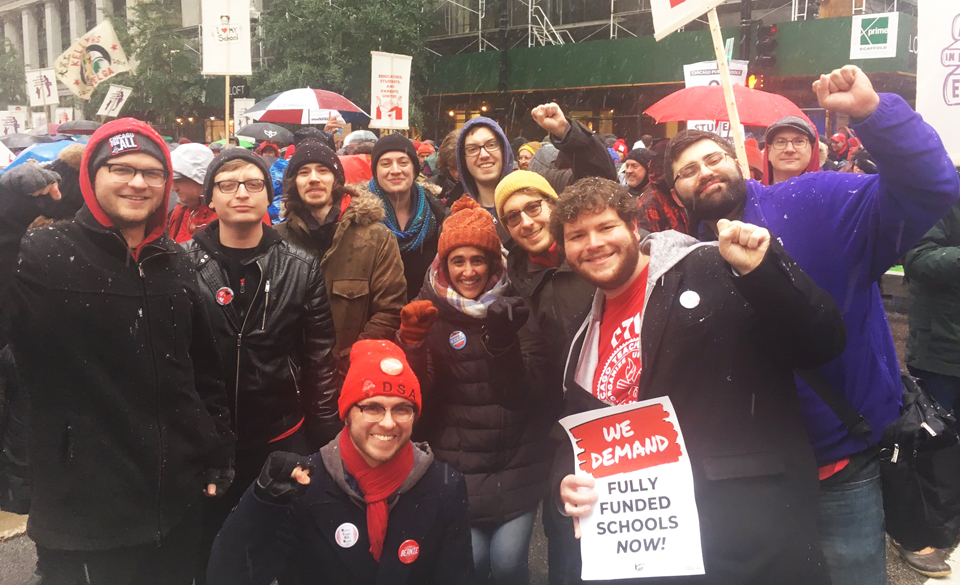
CHICAGO—Overcoming a last-minute snag from Mayor Lori Lightfoot, the Chicago Teachers Union, AFT Local 1, and their bosses in the Chicago Public School system reached tentative agreement on a new contract on Oct. 31, ending an 11-day forced strike.
The union’s House of Delegates approved the tentative agreement 362-242. Classes resumed the next day, even as the teachers union members voted on the pact.
The Chicago strike settlement is notable not just because the Windy City has the nation’s third-largest school district, with 25,000 teachers and 300,000 students.
It’s also notable because Chicago, seven years ago, is one key site where the new militancy and activism among the nation’s teachers – and other workers – began. In 2012, Local 1 members walked, too, and their prime objective wasn’t a pay hike.
Instead, it was a huge protest, which drew massive citywide support, against a school system being run like a business, and against then-Mayor Rahm Emanuel’s unilateral closure of 56 schools, virtually all of them serving students of color.
Those similar social and kid-oriented causes have since spread nationwide. School systems forced teachers and staffers to strike over sparse funding, corporate tax cuts which starved the schools of revenue, huge teaching loads, crumbling buildings and cuts in support staff, as well as low pay.
Subsequent forced, and successful, teacher strikes occurred in Kentucky, Oklahoma, Arizona, Indiana, Los Angeles, the Bay Area and – the biggest and most successful in reaching its goals – the entire state of West Virginia. Every school there shut down for nine days.
Local 1 President Jesse Sharkey proclaimed the latest forced strike, which began Oct. 17, a success, too.
“We have reached a landmark tentative agreement with CPS,” he declared.
Besides raises, the pact commits CPS to more counselors, nurses, librarians and other support staff in the schools, Sharkey told news services. Immediately details were not provided. But, Sharkey said, CPS agreement to increase school nurses, reduce class size, and to add social workers and resources for homeless students wouldn’t have been possible if teachers didn’t walk picket lines.
Local 1 was particularly concerned about huge classes in schools serving lower-income neighborhoods of people of color. Teachers reported having 40 kids, or more, in a kindergarten class, for example.
And counseling and aid to students with special needs were lacking. That led Local 1 and Service Employees Local 73, which represents support staffers, to fight for more counselors and aides. Local 73 reached its own pact, covering 7,500 staffers, several days before, but its members remained out on picket lines until CTU and its 25,000 teachers settled.
At least one advocate was dubious about CPS’s, and Chicago Mayor Lightfoot’s, commitment to teaching students with special needs. “You and Janice Jackson (the schools’ chancellor) certainly let us know how you feel about students with disabilities in CPS,” tweeted Christine Palmieri of the Chicago Special Education Disability Advocacy Committee.
“I am so disgusted. And after 11 days out. to go back to no social worker in until next Tuesday to help the kiddos deal with the transition back – I just can’t,” Palmieri’s tweet added.
The unions showed their solidarity and neighborhood residents joined in. Marches and picket lines were constant, including a mass march on Oct. 23 in rain and partial sleet through the Loop. Marchers carried a large banner declaring “This is what democracy looks like!”
And Democratic presidential hopeful Sen. Elizabeth Warren, D-Mass., and AFT President Randi Weingarten joined the picket lines the day before.
In the end, the union and CPS bosses compromised over what to do about the school days the kids missed, and whether the teachers and staff would get paid. Lightfoot held out for zero, the union demanded all 11, and they split the difference, arriving at five.
Teachers may get paid for all 11: The Chicago Sun-Times quoted the chair of the city council’s education committee as being willing to agree to that to get the kids back into the classrooms.
The march wasn’t the only indication of the pressure around the strike, English teacher Mary Rose O’Shea tweeted: “Strike Update, Day 10: My car window was smashed in during tonight’s @CTULocal1 HOD (House of Delegates) meeting. Only thing missing: My megaphone. They’re really trying to shut us up, folks.”
And teacher Michelle Gunderson, a Local 1 trustee, tweeted: “Lori Lightfoot took on a street fight with people who can handle 40 children in a kindergarten classroom. @CTULocal1.”
Lightfoot also complained about Local 1 “moving the goalposts” about the make-up days. That prompted angry responses from parents.
“Punishing the @CTULocal1 teachers for striking doesn’t feel like equity @chicagosmayor, it feels more like revenge. Let our kids have make up days, instruction matters. Missing two weeks of it does not sit well with parents,” one tweeted.

MOST POPULAR TODAY

Zionist organizations leading campaign to stop ceasefire resolutions in D.C. area


High Court essentially bans demonstrations, freedom of assembly in Deep South

Afghanistan’s socialist years: The promising future killed off by U.S. imperialism

Communist Karol Cariola elected president of Chile’s legislature






Comments